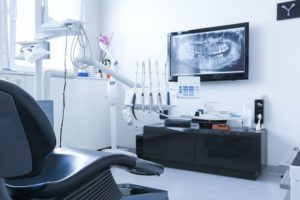Your dentist can tell a lot about your oral health with a visual examination of your teeth and gums. So why does your dentist also want to take x-rays of your teeth once a year? X-rays allow your dentist to see potential oral health issues that may lie beneath the surface of your smile.
The American Dental Association reports that dental x-rays are completely safe for your health. But you can feel more comfortable during this process when you know the benefits of this imaging. Read on to find four reasons that your dentist will want to capture your smile in an x-ray.

Reasons to Take X-Ray Imaging of Your Smile
Spot Hidden Tooth Decay
Sometimes a cavity, an early form of tooth decay, will have noticeable symptoms. You might feel pain in the affected tooth, bad-smelling breath, or dark spots and discoloration where the tooth enamel has become damaged.
But not all cavities are accompanied by these recognizable symptoms. This is why a dentist will recommend x-rays to make sure you do not have any cavities.
An x-ray can reveal cavities that are not visible to the naked eye. They will show up as a shadow or dark spot on the x-ray where the enamel has been eaten away. Then your dentist can give you a dental filling to treat the issue and stop further damage to your dental structure.
Check Tooth Pulp Health
An x-ray will show hard tissues in the body, like teeth and bone. While the pulp of a tooth is softer and is not visible in an x-ray, this imaging will reveal cysts or abscesses that might form in this vulnerable part of the tooth.
An infection within the tooth pulp will need urgent treatment, usually through root canal therapy. But other problems within the tooth pulp, like the non-vitality of the tissue, can also be spotted with an x-ray. If blood vessels do not flow as they should to a tooth, your dentist can know to monitor the problem going forward.
Monitor Tooth Growth
A dental x-ray can provide full images of your teeth, including those that have not grown into place yet. This way a dentist can look at the way the teeth grow and check if they have shifted. Misaligned teeth may lead to many dental concerns, so your dentist can keep an eye on this issue and suggest orthodontic treatment if needed to straighten your smile.
This x-ray can also look at wisdom teeth below the gumline. Often, wisdom teeth will cause significant problems when they begin to grow. Your dentist can monitor them and extract them before they cause damage to your smile.
Evaluate Jawbone Structure
X-ray imaging can capture both the teeth and the surrounding bone in the jaw. Checking the health of the jawbone is especially important if a patient has lost one or more teeth. The jawbone can deteriorate without the stimulation provided by a tooth root.
Your dentist can treat bone loss caused by missing teeth with tooth replacement using dental implants. But patients must have enough healthy jawbone to support an implant. X-rays allow a dentist to determine a patient’s eligibility for this restorative treatment.
